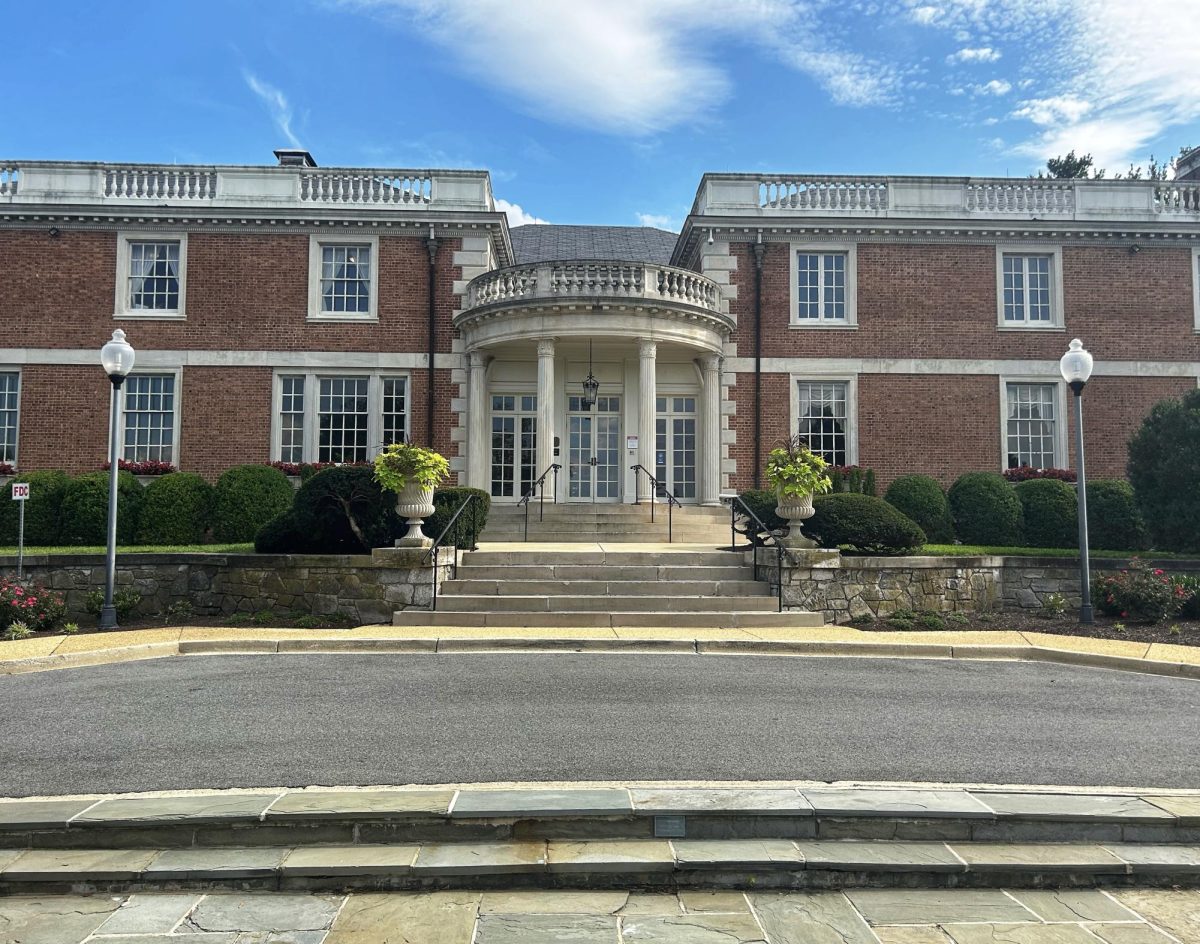“They’re there to see joy”: The Strathmore’s other stage
Since 1983, the Mansion has undergone regular renovations to suit the needs of the arts community, expanding galleries and tending to the ever-changing sculpture garden that greets visitors as they drive onto the property.
September 11, 2023
Just off Tuckerman Lane in Rockville, an inviting path travels up a hill on expansive rolling grounds. It winds between sets of carefully-planted bushes and below an elegant gazebo that watches over the landscape, all leading to the elegant Strathmore Mansion.
Though lesser known than the Strathmore Music Center, the Mansion carries its own history and creates its own distinct presence.
In 1899, D.C. dignitaries Captain James Frederick Oyster and his wife Emma acquired the North Bethesda land now known as the Strathmore campus and commissioned the nine-bedroom Mansion as a summer house. The building and grounds then changed hands several times in the twentieth century. Local bread-baking patent millionaires the Corbys remodeled and expanded the Mansion in the 1910s. Filipino president Manuel L. Quezon resided in it during World War II, using the space as a base of operations. It served as a convent for the nuns of St. Mary’s Academy and, in the two years preceding its purchase by Montgomery County, was the headquarters for the American Speech-Language-Hearing Association.
Upon acquiring the campus in 1979, Montgomery County lawmakers established the nonprofit Strathmore Hall Foundation to support the Bethesda art community and create the area’s first public center for the arts.
A restored Mansion soon opened to the public in 1983. Since then, it has undergone regular renovations to suit the needs of the arts community, expanding galleries and tending to the ever-changing sculpture garden that greets visitors as they drive onto the property. The lawn itself even became a popular music and art venue and is home to many free events throughout the year.
“Sometimes the entire lawn is overflowing with the audience, and they’re there to see joy, to take in what’s being presented to them,” Mansion volunteer Jane Welsh said. “You have fun, and that’s what I think is really important, to have people get together and enjoy an afternoon.”
Inside, the Mansion’s spacious, original indoor areas continue to accommodate modern performances; music teachers book rooms for recitals, and bands gather for small concerts. The home was “built for music,” according to Mansion and Exhibitions Director Lindsey Morris.
“When the house was first built or designed, music was a form of entertainment that’s very different than it is today because there weren’t competing forms of entertainment,” Morris said. “People enjoyed hearing live music, and we’ve continued that.”
With a background of live performances, organizers offer reservation-based “Afternoon Tea” each Tuesday and Wednesday, in addition to one Saturday a month. There, sets of antique teaware carry miniature, gourmet snacks and Strathmore’s Signature Blend Tea, made especially for the venue by Connecticut Master Tea Blender John Harneuy.
Art exhibitions displayed on the first and second floors of the Mansion are ever-changing. In 2022, the Strathmore featured the “Purpose-Repurpose!” exhibit from the nonprofit Studio Art Quilt Associates. Artists constructed the works from upcycled fabrics like tablecloths, jeans and dresses — one such piece, an elephant made of recycled army surplus goods and emergency blankets.
To choose these unique displays, the Strathmore’s Exhibitions Department looks for a high standard of art, considering diversity in medium, form and artist background, Morris said. The Mansion also hosts a juried exhibition, with open calls for artists to submit their work through online applications.
The Mansion gift shop supports local artists as well, carrying their unique works in its stock, and program curators set aside a gallery specifically for new artists to earn exposure.
Summer 2023 brought the “Meet the Makers” exhibition, in which local artist guilds open their practice to the public for a series of conversations with woodworkers, ceramicists and enamelists, among others. This fall, the Mansion will display the “Animal Kingdom: All Beasts Great & Small” exhibit, showcasing animal-inspired art in a variety of forms.
“The fact is that as you look around at the exhibits in Strathmore, no matter what they are, if they’re pastels, watercolors, middle works, or quilts, that is something that you as a person will appreciate,” Welsh said.
The volunteers who work at the Mansion are the reason its halls remain walked. They operate the front desk, greet visitors, serve tea, help to set up art projects and assist with other tasks around the venue, said Janey Richards, who has been a volunteer with Strathmore for 13 years.
“People at Strathmore really do appreciate their volunteers,” Richards said. “There’s just this surreal feeling of family, especially here at the Mansion, because we’re probably maybe 20-25 volunteers.”
Even during the COVID-19 pandemic, the staff within the Mansion were determined to continue hosting events. The site placed capacity limits on in-person rentals and adjusted exhibitions and opening receptions to make them accessible in a hybrid format. Volunteers hosted Facebook Live exhibition openings and guided video tours of the Mansion with sponsors and guests like Strathmore President and CEO Monica Jeffries Hazanangeles.
Mansion staff streamed “Living Room” concerts over Zoom and organized online discussions with artists, live from their studios, to give the public a chance to hear about their current and future projects. Even “Afternoon Tea” continued: people joined online to stream live music while enjoying tea and food delivered from the Mansion. Many community members understood the importance of staying connected during the pandemic, Morris said.
“Communities need to connect in times of celebration as well as in times of loss,” Morris said. “It’s just part of the human experience — and for your community to have a place for that is essential.”









